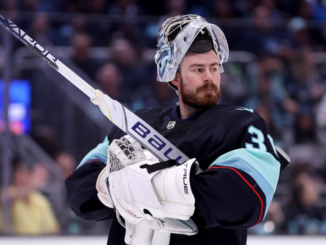
While the Edmonton Oilers and the Florida Panthers are battling for the Stanley Cup for the second consecutive postseason, the Seattle Kraken, along with 29 other teams, are left licking their wounds after an underwhelming 2024-25 campaign. Seattle’s new-look front office, along with new head coach Lane Lambert, is now tasked with steering a floundering ship back towards Stanley Cup contention.
OSN’s Kraken offseason review began with highlighting Seattle’s four keys to a successful summer and now includes evaluating potential decisions on the team’s pending free agents and taking note of three lessons to be learned from the two Stanley Cup Finalists. Next on the list: how to make a big splash in the trade market.
The Kraken’s collection of picks and prospects gives them the ammunition to take a big swing this summer. Seattle owns 10 combined picks across the first and second rounds of the next three drafts, and 12 across the first three rounds until 2027. They could add to that already impressive total by trading one or more of Jaden Schwartz, Jordan Eberle, or Jamie Oleksiak this offseason, three veterans aged 32 or older with only one year remaining on their contracts.
The Kraken will likely add another top prospect to their highly-rated prospect pool with pick number eight at the 2025 NHL Entry Draft, and could use their surplus of promising young forwards to fortify the system elsewhere. A young, NHL-ready defenseman should be the prime target given the organization’s lack of depth in that department. Luckily, there are several restricted free agent (RFA) defensemen who could be pried away from their current teams, but they are not the focus of this column.
Instead, we take aim at five forwards (the market for defensemen under contract isn’t bountiful) who are either currently under contract and are prime trade candidates due to underperformance, cap reasons, or off-ice issues. Let’s dive into those names and how they can make the Kraken better next season and beyond.
Jason Robertson, Dallas Stars
2024-25 Statistics: 82 Games Played (GP) – 35 Goals (G) – 45 Assists (A) – 80 Points (PTS)
Mason Marchment, Dallas Stars
2024-25 Statistics: 62 GP – 22 G – 25 A – 47 PTS
There are conflicting reports about which players are on the market and who the Stars would prefer to movebut given that both Robertson and Marchment’s situations are inextricably linked, let’s tackle the two forwards together.
The Stars, fresh off losing to the Oilers in the Western Conference Final, enter the 2025 offseason facing a major cap crunch. The team has committed $90.55 million to eight forwards, six defensemen, and two goalies for the 2025-26 season, with a meager $4.95 million remaining to allocate to at least four more forwards.
Cody Ceci, Mikael Granlund, Jamie Benn, Matt Duchene, Evgenii Dadonov, Colin Blackwell, Mavrik Bourque, and Nils Lundkvist are the team’s notable unrestricted (UFA) and restricted (RFA) free agents. Those eight skaters collectively accounted for just under $24 million against the cap last season so there is bound to be roster turnover this offseason, even in a rapidly rising cap environment.
Complicating things is the fact that Robertson, Marchment, and Thomas Harley will need extensions next summer, with Robertson and Harley in particular due for massive raises after previously inking cheaper bridge deals.
The American winger is young (he turns 26 in July), big (6-foot-3 and 201 pounds), and one of the most offensively gifted forwards in the league. Since his first full NHL season in 2020-21, he ranks 15th among all skaters in goals, 21st in assists, and 13th in points. While the Kraken should do anything to acquire such a talent if he is truly available, it’s difficult to believe that Robertson would be traded ahead of overpaid veteran defensemen in Matt Dumba (one year left at $3.75 million) and Ilya Lyubushkin (two years left at $3.25 million).
On the other hand, Marchment is older (he turns 30 this week), is a UFA once his contract expires, and boasts the size (6-foot-5) and playing style that NHL executives salivate over during the playoffs. He’s had some injury troubles in recent seasons, but has also scored at a 23-goal, 55-point pace over the past four seasons while only playing 15 minutes per game in all situations over that span. While his age profile and injury history aren’t appealing, the Kraken shouldn’t scoff at acquiring a good middle-six forward if the Stars are willing to sell him for peanuts.
Alexis Lafreniere, New York Rangers
2024-25 Statistics: 82 GP – 17 G – 28 A – 45 PTS
Why would the New York Rangers trade a 23-year-old winger one year removed from a 28-goal season? It’s because everything is bigger in New York, and that includes organizational crises.
General manager Chris Drury’s job is on the line after a season in which turmoil on and off the ice saw the Rangers, two wins away from the Stanley Cup Final last spring, drop 29 points in the standings compared to 2023-24 and miss the playoffs for the first time since 2021.
Former Pittsburgh Penguins head coach Mike Sullivan has already been hired to replace the outgoing Peter Laviolette, leaving Drury (GM and President of Hockey Operations since 2021) without many cards left to play. Given that most of the Rangers’ wounds are self-inflicted, it’s hard to feel much sympathy for the former NHL star. He’s already unloaded longtime Ranger Chris Kreider, and there is reason to believe more significant moves are in store.
Lafreniere’s name has emerged in trade rumors due to a poor season after being given a handsome contract worth $7.45 million through the 2031-32 season. The Quebec native has struggled to live up the billing of being a first-overall pick (2020), and could be suited for a fresh start away from the Big Apple. He and RFA defender K’Andre Miller are more attractive trade chips than overpaid and underperforming veterans such as Mika Zibanejad or Vincent Trochek, which earned him his place on this list.
Like most of the players on this list, Lafreniere’s trade value is at its lowest. He’s still young enough that he has time to leverage his clear physical gifts into being a top winger in the league, draft pedigree aside. It seems foolish not to at least see what he can do under Sullivan’s tutelage, especially since Laviolette has earned a reputation for being hard on up-and-coming talent.
It was the same dynamic that saw Kaapo Kakko openly talk to the media about his on-ice usage and Laviolette’s hypocritical treatment of young players compared to veterans. Kakko was traded for pennies on the dollar and has now blossomed in a more youth-friendly environment in Seattle. The Kraken should at least inquire about acquiring Lafreniere, even if Drury is wary of once more being bitten by a regrettable trade.
Isaac Howard, Michigan State University (Tampa Bay Lightning)
2024-25 Statistics: 37 GP – 26 G – 26 A – 52 PTS
While technically not on an NHL contract, the 21-year-old left winger is high up on NHL trade boards. Recent reports suggest that Lightning GM Julian Brisebois does not believe Howard is interested in signing a contract with the organization, partially due to differing views in his path to a full-time role in the NHL. Rather than walking him to free agency, the Lightning could look to trade his rights to a team with a clearer road to the NHL, something the Kraken could offer if they continue to clear out their forward ranks.
Howard has scored 34 goals and 88 points in 73 games over his last two seasons with Michigan State in the NCAA and won the 2025 Hobey Baker Award as the college circuit’s most outstanding player.
The cost of acquiring Howard might not be very high, given his ability to become an unrestricted free agent next spring. The Kraken could dangle one of their 12 second-to-fourth-round picks over the next three drafts, with Howard being more of an NHL-ready prospect than any player Seattle could draft in that range.
Elias Pettersson, Vancouver Canucks
2024-25 Statistics: 64 GP – 15 G – 30 A – 45 PTS
The 2024-25 season was a nightmare for the Vancouver Canucks on and off the ice. The team followed up a surprising 109-point campaign and a second-round playoff appearance with an underwhelming 90-point season marked by drama and infighting. The Canucks were rumoured to be choosing between J.T. MIller and Elias Pettersson in the feud, with the older Miller traded to the Rangers midway through the season.
If Vancouver is still interested in a trade to get off of his hefty $11.6 million per year contract (which runs through 2031-32), the Kraken would be taking a huge risk on a player who, despite his recent setbacks, still ranks 51st among all NHL skaters in goals, 25th in assists, and 24th in points over the past three seasons.
Assuming a bounce-back season is in order, Pettersson would immediately become Seattle’s most talented player. The 26-year-old’s arrival would also give them the luxury of a 1-2-3-4 punch of Pettersson, Matty Beniers, Chandler Stephenson, and Shane Wright down the middle, assuming none of those four were involved in the trade.
Pettersson’s cap hit is potentially crippling if he continues to struggle so any acquiring team would have to be sure that he remains closer to the player who scored 102 points in 2022-23, rather than the one who only tallied 45 points in 2024-25.
Trading for the Swedish pivot would be as big of a swing as the team could possibly take and the Canucks might not want to send him to a division rival, but there is definitely smoke around the center’s future in British Columbia, especially with his no-trade clause set to kick in on July 1.
Kraken Could Be Bold During 2025 Offseason
I have long preached patience and advocated for the Kraken to embark upon a rebuild given the nature of roster-building in the salary cap era, but the conditions are right for Seattle to take a calculated swing this summer.
With a ton of draft capital, intriguing forward prospects, and a number of under-25 players already in big roles on the NHL roster, the revamped front office might look to expedite the rebuild. Is an ambitious offseason in the works, or will careful patience win out?




